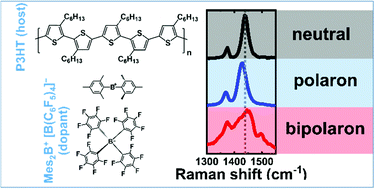Understanding the evolution of the Raman spectra of molecularly p-doped poly(3-hexylthiophene-2,5-diyl): signatures of polarons and bipolarons†
Abstract
Molecular doping is a key process to increase the density of charge carriers in organic semiconductors. Doping-induced charges in polymer semiconductors result in the formation of polarons and/or bipolarons due to the strong electron-vibron coupling in conjugated organic materials. Identifying the nature of charge carriers in doped polymers is essential to optimize the doping process for applications. In this work, we use Raman spectroscopy to investigate the formation of charge carriers in molecularly doped poly(3-hexylthiophene-2,5-diyl) (P3HT) for increasing dopant concentration, with the organic salt dimesityl borinium tetrakis(penta-fluorophenyl)borate (Mes2B+ [B(C6F5)4]−) and the Lewis acid tris(pentafluorophenyl)borane [B(C6F5)3]. While the Raman signatures of neutral P3HT and singly charged P3HT segments (polarons) are known, the Raman spectra of doubly charged P3HT segments (bipolarons) are not yet sufficiently understood. Combining Raman spectroscopy measurements on doped P3HT thin films with first-principles calculations on oligomer models, we explain the evolution of the Raman spectra from neutral P3HT to increasingly doped P3HT featuring polarons and eventually bipolarons at high doping levels. We identify and explain the origin of the spectral features related to bipolarons by tracing the Raman signature of the symmetric collective vibrations along the polymer backbone, which – compared to neutral P3HT – redshifts for polarons and blueshifts for bipolarons. This is explained by a planarization of the singly charged P3HT segments with polarons and rather high order in thin films, while the doubly charged segments with bipolarons are located in comparably disordered regions of the P3HT film due to the high dopant concentration. Furthermore, we identify additional Raman peaks associated with vibrations in the quinoid doubly charged segments of the polymer. Our results offer the opportunity for readily identifying the nature of charge carriers in molecularly doped P3HT while taking advantage of the simplicity, versatility, and non-destructive nature of Raman spectroscopy.



 Please wait while we load your content...
Please wait while we load your content...